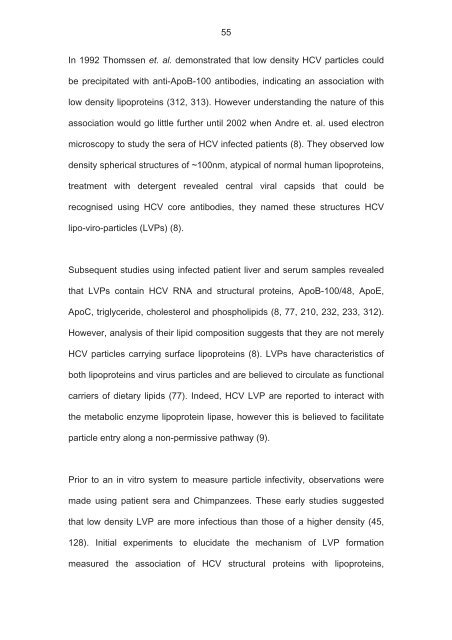The role of scavenger receptor BI in hepatitis - eTheses Repository ...
The role of scavenger receptor BI in hepatitis - eTheses Repository ...
The role of scavenger receptor BI in hepatitis - eTheses Repository ...
Create successful ePaper yourself
Turn your PDF publications into a flip-book with our unique Google optimized e-Paper software.
55<br />
In 1992 Thomssen et. al. demonstrated that low density HCV particles could<br />
be precipitated with anti-ApoB-100 antibodies, <strong>in</strong>dicat<strong>in</strong>g an association with<br />
low density lipoprote<strong>in</strong>s (312, 313). However understand<strong>in</strong>g the nature <strong>of</strong> this<br />
association would go little further until 2002 when Andre et. al. used electron<br />
microscopy to study the sera <strong>of</strong> HCV <strong>in</strong>fected patients (8). <strong>The</strong>y observed low<br />
density spherical structures <strong>of</strong> ~100nm, atypical <strong>of</strong> normal human lipoprote<strong>in</strong>s,<br />
treatment with detergent revealed central viral capsids that could be<br />
recognised us<strong>in</strong>g HCV core antibodies, they named these structures HCV<br />
lipo-viro-particles (LVPs) (8).<br />
Subsequent studies us<strong>in</strong>g <strong>in</strong>fected patient liver and serum samples revealed<br />
that LVPs conta<strong>in</strong> HCV RNA and structural prote<strong>in</strong>s, ApoB-100/48, ApoE,<br />
ApoC, triglyceride, cholesterol and phospholipids (8, 77, 210, 232, 233, 312).<br />
However, analysis <strong>of</strong> their lipid composition suggests that they are not merely<br />
HCV particles carry<strong>in</strong>g surface lipoprote<strong>in</strong>s (8). LVPs have characteristics <strong>of</strong><br />
both lipoprote<strong>in</strong>s and virus particles and are believed to circulate as functional<br />
carriers <strong>of</strong> dietary lipids (77). Indeed, HCV LVP are reported to <strong>in</strong>teract with<br />
the metabolic enzyme lipoprote<strong>in</strong> lipase, however this is believed to facilitate<br />
particle entry along a non-permissive pathway (9).<br />
Prior to an <strong>in</strong> vitro system to measure particle <strong>in</strong>fectivity, observations were<br />
made us<strong>in</strong>g patient sera and Chimpanzees. <strong>The</strong>se early studies suggested<br />
that low density LVP are more <strong>in</strong>fectious than those <strong>of</strong> a higher density (45,<br />
128). Initial experiments to elucidate the mechanism <strong>of</strong> LVP formation<br />
measured the association <strong>of</strong> HCV structural prote<strong>in</strong>s with lipoprote<strong>in</strong>s,

















